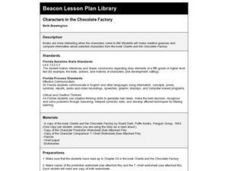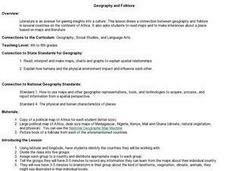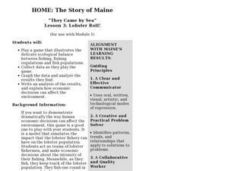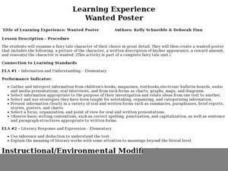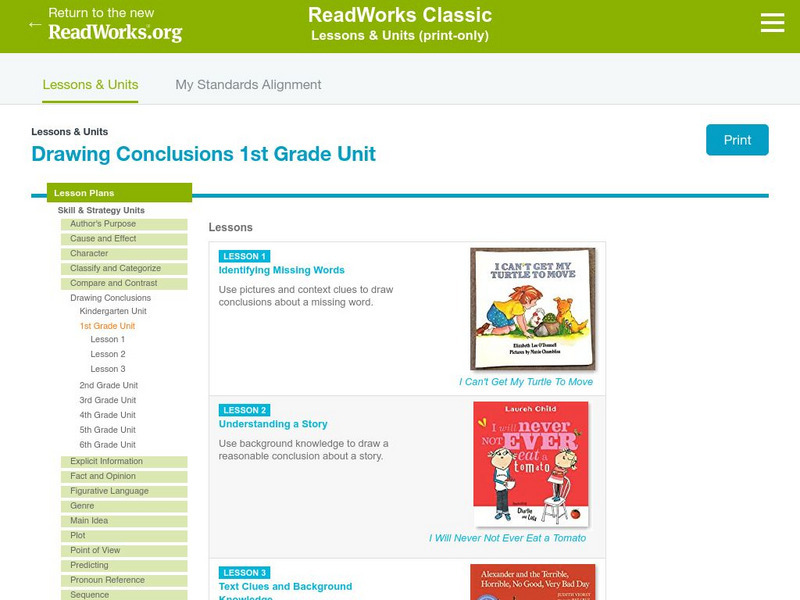Curated OER
Helping Children Read
Students read books with younger children, incorporating context clues and vocabulary aids as reading strategies to help the younger children learn to read. They discuss the concept of community capital and how this activity relates.
Curated OER
Effective Photojournalism
Students determine what makes a quality photo and take and edit appropriate photos that relate to their assigned articles. They select good pictures for their publication.
Curated OER
Characters in the Chocolate Factory
Students dress and act as selected characters from Roald Dahl's "Charlie and the Chocolate Factory". They identify each other and make predictions about the upcoming chapters based on their observations about the characters.
Curated OER
Learning to Read Primary Documents
Students research primary source documents related to the Canadian Loyalist theme at Canada's Learning Center website. They examine a painting, a list and a discharge notice of a soldier.
Curated OER
Social Studies: African Folklore and Geography
Students discover the connection between geography and folklore in several African nations. In groups, they record information from maps of their assigned countries. Students observe the pictures in books and match the geographic...
Curated OER
Magazine Madness
Learners look at pictures cut out of magazines to determine what is happening in the picture and predict what will happen next.
Curated OER
Immigration in the Connecticut River Valley
Young scholars discuss and compare immigration during the 18th century to the Connecticut River Valley to that in America during the turn of the century.
Curated OER
Parenting Styles
Students identify the traits of different parenting styles and discuss how they effect the students that are raised in that manner. They present their observations to the class.
Curated OER
Lesson 3: Lobster Roll!
Students play a game that illustrates the delicate ecological balance between fishing, fishing regulations and fish populations. They collect data and analyze the results.
Curated OER
Wanted Poster
Pupils examine a fairy tale character of their choice in great detail. They create a wanted poster that includes the following: a picture of the character, a written description of his/her appearance, a reward amount, and reasonthe...
Curated OER
Stratigraphy -- Layers of Time in the Earth
Students are introduced to the process of stratification. Using the internet, they read about the Richard Beene archeological site near San Antonio. Using a map, they color code the different layers present at this site and answer...
Curated OER
Rock Art
Students create replica symbols of rock are found in Wisconsin and work cooperatively to create a rock art panel. They observe rock art to find their meanings and reasons why they were created.
Curated OER
The Chromosome Connection
Students evaluate the degree of chromosome similarity and difference between humans and apes. Students infer about the relationship between a human and ape based on similarities found.
Curated OER
The Death of the Ball Turret Gunner
Pupils read and analyze a poem about a speaker's posthumous view of war, assess the purpose of an author's note and evaluate the effect of the point of view on the reader's response. They work in groups to discuss and analyze the poem.
Curated OER
North or South? Which has a better way of life?
Sixth graders brainstorm what they believe are the causes of the Civil War. They copy the blank circle graph into their Social Studies journals twice once for their prediction and once for the actual. Students list the following...
Smithsonian Institution
Smithsonian Learning Lab: Every Picture Has a Story
Smithsonian Education presents "Every Picture Has a Story". Teachers can download this comprehensive teaching package in which students examine some of the millions of photographs in the Smithsonian. This amazing teaching package comes...
Other
Freedom on the Move: Telling Their Stories
The "Telling Their Stories" lesson plan guides students through the era of enslavement through the lens of those who chose to flee as a form of resistance. Using the Freedom on the Move database of runaway ads, this lesson centers on the...
Read Works
Read Works: Drawing Conclusions 1st Grade Unit
[Free Registration/Login Required] A three-lesson unit on drawing conclusions through which students learn how to use pictures and context clues to discover a missing word and to draw conclusions about a story. Students also use...
National Endowment for the Humanities
Neh: Edsit Ement:charlotte Perkins Gilman's "The Yellow Wall Paper" Writing Women
A close reading of "The Yellow Wall-paper" employing the analysis of such literary concepts as setting, narrative style, symbol, and characterization. Students will write an essay discussing what the story suggests about middle-class...
PBS
Pbs Learning Media: Molly of Denali: Dream Tube Lesson Plan
Use this comprehensive lesson as part of a comprehensive literacy, STEM, or social studies unit in which children will be using informational texts. In the "Dream Tube" animated story from the PBS Kids series Molly of Denali, Molly and...
PBS
Pbs Learning Media: Molly of Denali: A Splash of Mink Lesson Plan
In the animated 11-minute story "A Splash of Mink," from the PBS KIDS series MOLLY OF DENALI, Molly and Trini must find a remedy after being sprayed by a mink. Despite getting advice from various sources about how to get rid of the...
Read Works
Read Works: Drawing Conclusions Kindergarten Unit: Short Story
[Free Registration/Login Required] A lesson plan teaching students to make conclusions based on a sentences and short texts. Students use textual cues to explain how the conclusions were reached. Ideas for direct teaching, guided...
Alabama Learning Exchange
Alex: What a Character!
This lesson opens up the world of writing by introducing students to the point of view in a story. Students will have the opportunity to read a new version of a classic story and see how it changes when it is written from another...
Better Lesson
Better Lesson: Miss Nelson Is Back
First graders tell what is happening in the story, but use words and phrases from the story to tell how they know.




